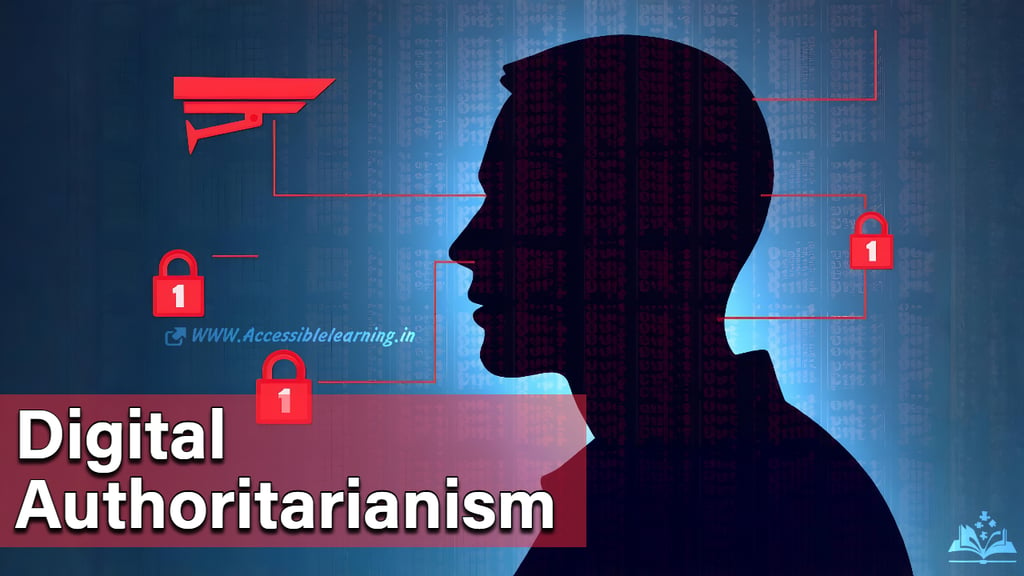
The Rise of Digital Authoritarianism: How Technology Transforms State Control
Explore how governments worldwide are leveraging digital technologies to expand control over citizens. This comprehensive analysis examines surveillance systems, censorship mechanisms, and the global spread of digital authoritarianism, along with potential countermeasures and implications for democracy in the digital age.
AWARE/VIGILANTEDUCATION/KNOWLEDGEAI/FUTURENEW YOUTH ISSUES
Sachin K Chaurasiya
5/9/20257 min read


In an age where digital technology permeates every aspect of modern life, governments worldwide have discovered powerful new tools for surveillance, censorship, and social control. This troubling phenomenon—digital authoritarianism—represents one of the most significant threats to democratic values and human rights in the 21st century.
What Is Digital Authoritarianism?
Digital authoritarianism refers to the use of digital technologies by governments to monitor, manipulate, and control their citizens. Unlike traditional forms of authoritarianism that rely primarily on physical force and intimidation, digital authoritarianism operates in the shadows of ones and zeros, often invisible until its effects become painfully apparent.
These regimes deploy a sophisticated arsenal of digital tools to:
Monitor citizens through mass surveillance
Censor information and control narratives
Track dissidents and silence opposition
Manipulate public opinion through disinformation
Restrict internet access and digital freedoms
The term gained prominence around 2018 when organizations like Freedom House began documenting the deliberate export of digital control technologies from authoritarian states to emerging democracies. What makes digital authoritarianism particularly insidious is its ability to create what scholars call "plausible deniability"—regimes can claim they're merely implementing smart city technologies or protecting citizens from harmful content while simultaneously building elaborate systems of control.
The Global Expansion of Digital Control
What began as isolated experiments in a handful of authoritarian states has evolved into a global playbook for digital control. Countries like China have pioneered comprehensive systems that combine surveillance cameras, facial recognition, social credit scoring, and internet censorship to create unprecedented mechanisms for social management.
The scope is staggering—China alone has deployed over 626 million surveillance cameras nationwide, approximately one camera for every two citizens. Their Great Firewall employs an estimated 50,000 internet police officers who monitor content and enforce censorship directives. Russia's SORM system legally requires all internet service providers to install government hardware that mirrors all network traffic directly to FSB (Federal Security Service) facilities.
Perhaps most concerning is how these practices have begun to spread. Nations with established democratic traditions are now adopting elements of digital authoritarianism, often justified under the banner of national security, public safety, or pandemic response. In 2019, at least 33 of 65 countries assessed by Freedom House had procured AI surveillance technologies from Chinese companies like Huawei, Hikvision, ZTE, and CloudWalk Technology.


The Technology Behind the Curtain
Digital authoritarianism relies on several key technological innovations:
Artificial Intelligence and Machine Learning
AI-powered facial recognition can identify individuals in crowds, track their movements across cities, and even predict behavior. Machine learning algorithms analyze vast amounts of data to identify patterns, relationships, and potential threats to regime stability.
The Skynet system in China's Xinjiang region exemplifies this approach—naming itself, perhaps unwittingly, after the villainous AI system from the Terminator films. This system processes data from thousands of checkpoints, surveillance cameras, and digital records to flag "suspicious" individuals for further scrutiny or detention. According to leaked documents, the system has flagged tens of thousands of individuals for investigation based solely on algorithmic assessments of their "potential for extremism" calculated from everyday behaviors like irregular electricity usage or entering buildings through side doors.
Big Data Analytics
Governments collect enormous datasets on citizens' communications, movements, purchases, and social connections. This information creates detailed profiles that reveal political leanings, personal networks, and vulnerabilities that can be exploited.
Internet Control Infrastructure
Deep packet inspection, content filtering, and domain blocking allow regimes to create highly customized censorship systems. Some countries have developed capabilities to completely disconnect from the global internet during periods of unrest—creating national "kill switches."
Social Media Manipulation
Automated bot networks, coordinated inauthentic behavior, and algorithmic manipulation spread pro-government narratives while undermining opposition voices. These techniques create the illusion of popular support while drowning out dissent.
Real-World Impacts on Human Rights
The rise of digital authoritarianism has profound implications for fundamental human rights:
Freedom of Expression
When governments monitor all communications and punish dissenting views, self-censorship becomes widespread. Citizens no longer feel safe expressing political opinions, criticizing authorities, or organizing for change.
Privacy Rights
Mass surveillance eliminates the concept of privacy in public and increasingly in private spaces. The psychological impact of constant monitoring creates a chilling effect on free thought and association.
Information Access
Content filtering and internet shutdowns restrict access to independent news, alternative perspectives, and communication tools. Citizens become isolated in government-approved information bubbles.
Political Participation
When digital tools monitor political activities and punish engagement with opposition groups, democratic participation withers. Elections become theatrical performances rather than meaningful exercises of popular will.
The Export of Digital Authoritarianism
Perhaps most alarming is how authoritarian regimes now export their surveillance technologies and censorship expertise to other nations. These exports typically come with few human rights safeguards and often include training in repressive techniques.
Through programs like China's "Digital Silk Road," surveillance infrastructure and governance models are spreading to developing nations that lack robust legal frameworks to prevent abuse. This digital colonialism threatens to reshape global governance norms away from openness and toward control.


The Corporate Dimension
Technology companies play a complicated role in this landscape. While some actively develop and market surveillance technologies to authoritarian regimes, others find themselves unwillingly coopted or pressured into compliance with government demands.
Western technology firms face difficult choices when operating in markets with authoritarian tendencies. Should they comply with local censorship laws to maintain market access? Where should they draw ethical lines around data sharing and surveillance assistance?
Democratic Responses and Digital Resistance
Despite these troubling trends, resistance to digital authoritarianism continues to evolve:
Technical Countermeasures
Encrypted messaging apps, virtual private networks (VPNs), and anonymity tools help citizens evade surveillance and access blocked content. These digital safe havens become increasingly important as control systems expand.
Legal and Regulatory Frameworks
Democratic nations are developing new privacy laws, export controls on surveillance technologies, and human rights standards for technology deployment. The EU's General Data Protection Regulation (GDPR) represents one attempt to establish guardrails.
Digital Literacy Initiatives
Teaching citizens to recognize manipulation, protect their data, and critically evaluate information sources builds societal resilience against digital control. These skills have become essential components of democratic citizenship.
Civil Society Monitoring
Organizations tracking digital rights abuses play a crucial watchdog role by documenting incidents, sharing circumvention techniques, and advocating for policy reforms. Their work ensures abuses do not remain hidden.
The Path Forward
The struggle between digital authoritarianism and digital democracy represents one of the defining conflicts of our time. The outcome will shape political realities for generations to come.
Democratic societies must demonstrate that effective governance doesn't require sacrificing fundamental rights. This means developing regulatory frameworks that harness technology's benefits while preventing its abuse, strengthening democratic institutions against digital manipulation, and promoting global norms that prioritize human dignity over social control.
Citizens likewise must remain vigilant about incremental expansions of surveillance powers, even when justified by legitimate concerns. History teaches that emergency measures often outlive the emergencies that spawned them.
FAQ's
Is digital authoritarianism only a problem in authoritarian countries?
No. While authoritarian regimes implement the most comprehensive digital control systems, many democratic nations have adopted concerning surveillance practices. The Five Eyes intelligence alliance (US, UK, Canada, Australia, and New Zealand) operates global surveillance programs that collect vast amounts of data on citizens. The key difference often lies in legal oversight, transparency, and citizens' ability to challenge these systems.
How can ordinary citizens protect themselves from digital surveillance?
While perfect protection is impossible against state-level actors, individuals can take meaningful steps:
Use encrypted messaging apps like Signal for sensitive communications
Employ VPNs to mask internet activity
Consider privacy-focused browsers and search engines
Be mindful of what you share on social media
Support digital rights organizations advocating for stronger protections
Doesn't surveillance help prevent terrorism and crime?
While targeted surveillance can aid legitimate security efforts, mass surveillance has shown limited effectiveness in preventing terrorism. Studies suggest these programs primarily excel at retroactive investigation rather than prevention. Moreover, the societal costs of normalized mass surveillance—including chilling effects on free expression and democratic participation—may outweigh security benefits.
Are private companies just as concerning as governments when it comes to surveillance?
Corporate and government surveillance represent different but related challenges. Corporate surveillance primarily aims to influence consumer behavior, while government surveillance directly impacts civil liberties and political rights. However, the line blurs when governments pressure or legally compel companies to share data. The most concerning scenarios involve public-private surveillance partnerships that combine the pervasive data collection of tech platforms with the coercive power of the state.
What international agreements exist to limit digital authoritarianism?
Currently, no comprehensive international framework specifically addresses digital authoritarianism. Existing human rights instruments like the Universal Declaration of Human Rights and the International Covenant on Civil and Political Rights provide some foundation but were drafted before the digital age. Organizations like the United Nations and the European Union are working to develop new governance frameworks, but progress remains slow amid geopolitical tensions.


Digital authoritarianism represents a profound evolution in how states exercise power. By transforming information technologies from tools of liberation into instruments of control, authoritarian regimes have discovered new methods to entrench their rule while projecting an appearance of normalcy.
Yet technology itself is neutral—the same innovations powering surveillance states can strengthen democratic participation, increase transparency, and empower citizens. The critical question isn't whether technology will transform governance, but whether we can ensure those transformations enhance human freedom rather than diminish it.
The answer depends not just on technical solutions or policy responses, but on our collective willingness to defend democratic values in digital spaces. In a world increasingly shaped by algorithms and artificial intelligence, preserving human agency and dignity requires nothing less.
Subscribe To Our Newsletter
All © Copyright reserved by Accessible-Learning Hub
| Terms & Conditions
Knowledge is power. Learn with Us. 📚


